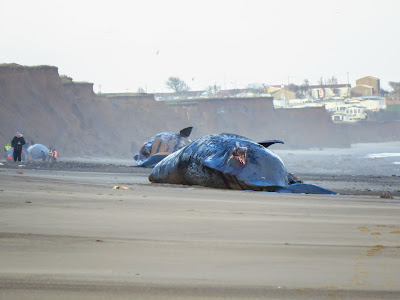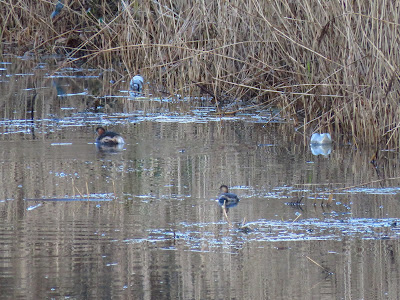A mass stranding of ten Sperm Whales was reported on Christmas Eve in the stretch of coast between Withernsea and Tunstall. I've never seen a whale stranding before and, although a very sad event, it allows for a rare occasion to experience these large mammals up close. Last night, finding that some of the whales were still on the beach I decided to pay them a visit.
It was a clear morning, with large shower clouds, but it fortunately kept dry for us. Low tide was at about 10 am, ideal to walk on this stretch of coast, as watching from the crumbly cliffs after the last rains is not advisable. After parking by Withernsea's Memorial Gardens, we walked along the north promenade, and upon reaching the end of it, two of the whales became visible in the distance. There were a few people about, several wearing masks, and it was easy to keep social distance.
A short brisk walk and we reached the first whale. The first impression, after taking in the immense size of it, was the fact that the penis was everted, making it very obvious that this, like the other individuals, were all male. We walked around the whale, taking in its odd anatomy. Sadly, it's jaw had been cut off and taken away by a looter. This, according to the team carrying out the necropsy, makes their job harder, in addition to being an illegal act to take possession to any part of a cetacean.
Some Sperm whale facts
Physeter macrocephalus, Linnaeus, 1758
The largest toothed whale, a deep-water squid-eating specialist. Sperm whales are cosmopolitan and found at deep waters all around the world. The population of sperm whales is quite mixed, with little genetic structure around the world.
The head is massive and block-shaped (the 'macrocephalus' of the species name meaning massive head) and can make up to a third of the body length of a bull. It contains a large fibrous sac filled with a mix of oils and waxes, the spermaceti, which is used in echolocation and may also aid with the animal buoyancy. The spermaceti and was one of the valued products of their hunt as it was used to make high quality lubricants.
The sperm whale is a strong contender to the deepest and longest animal diver. Bulls can dive down over 2,000 m deep to hunt on the sea floor, although dives are often shallower, to about 400 m. Dives take from half an hour to a record of just over 2 hours long.
Sperm whales have a single, S-shaped blow hole, the left one. The left nasal passages are used to make sounds. Their blow spray is low and distinctly asymmetrical, pointing left and forward.
They have the largest brain of any animal. In contrast, their eyes are relatively small and conical, and can be retracted and protruded from the eye cavity.
Strongly sexually dimorphic, males can be up to 3 times as heavy as females, with average weight at maturity 44 tonnes for males (max of 80!) and length of 16 m, whereas females weigh 13 tonnes and measure 11 m. Bulls reach sexual maturity at 18-20 years old and can live up to 70 years old. Males are able to dive deeper and carry on growing until they reach 50 years old. Sexes are segregated in their geographical distribution, adult males live in higher latitude cold waters, while females stay in warm, tropical seas in family groups year round. Immature males leave their natal groups at 10-15 years, when they join 'bachelor groups' and migrate to northern waters. As they age they become less social, and mature bulls become solitary, only visiting female groups in tropical waters to mate.
Adult females, their calves, and immature offspring form strongly social groups called 'mixed groups', likely to be structured as elephant's herds into maternal lines. Young may be cared for all females in the group. This 'babysitting' allows mothers to feed, as dives can take a long time, when the calves can be exposed to predators. In the North Atlantic the Canaries and Azores are important breeding grounds.
Communication is by series of clicks or 'codas', which may be individual specific. Males also 'clang'. Echolocation involves the emission of powerful clicks aiding in the localisation of prey such as medium to large size squid in the deep sea, but also sharks and rays from the sea floor.
History of Sperm Whale strandings
Sperm whales have stranded in the north sea for centuries, the earliest record in 1560, and this species have the best recorded stranding history of any cetacean. The most famous historical stranding is that of a 17 m long young male Sperm Whale in 1825 just in this very same stretch of coast. This is the account of the stranding by James Alderson, the surgeon from Hull who carried out the dissection of the animal:
[the sperm whale] was seen on the after noon of Thursday the 28th of April, drifting up from the southward with the ebb tide, off Tunstall in Holderness , and in the course of the afternoon was landed low in the tide . At the ensuing flood it was floated higher up on the beach , where it was left during the early part of the ebb. It may seem extraordinary, but it is no less true, that it was not generally known in Hull to be on shore until the Tuesday following.
The carcass was claimed by the then Lord of Holderness Sir Thomas Constable, its skeleton cleaned and eventually mounted on the grounds of Burton Constable. This skeleton was then unique in the world and was visited and described in minute detail by Thomas Beale in his monograph 'The Natural History of the Sperm Whale', from which Herman Melville borrowed widely for his 'Moby Dick' novel. The remains of this sperm whale skeleton (missing the jaw) now resides at Burton Constable.
Why did they strand, is it do do with human activities?
The southern basin of the North Sea is a hotspot for sperm whale stranding. All sperm whale strandings in the North Sea are of males, most of bachelor herds formed by immature individuals, and are strongly concentrated between November and March. Sperm whales are deep sea animals that don't belong to the shallow North Sea (depth is less than 40 m). They visit the deep waters of the Norwegian Sea, where they find plentiful squid (Gonatus fabricii), which can be easy to catch in their spawning grounds. In the late autumn and winter they migrate south through the Faeroe-Shetland channel. It is during this migration that some some bachelor herds may take a wrong turn and move into the southern basin of the North Sea, where the sea is progressively shallower, with sandy, gradually changing depths where their echolocation is not as efficient as in deeper seas and where they are highly likely to end beached. They are such massive animals that rescue is not an easy option and then, even if it were possible, the whales would be unlikely to find their way back to safer waters.
Despite the long history of strandings in the North Sea, their frequency across years changes markedly. There appear to have been an increase since the 70s. There was a large number of strandings in 1996 and 1997, then a long period with few strandings, and a large number again in 2016. This could be related to the long-term recovery of the sperm whale population after whaling stopped (in the 80s), but there is no good population estimates. In early 2016, 30 Sperm whales were stranded in five countries around the southern North Sea. Researchers took advantage of this to collect as much data as possible from the whales, and try to ascertain the reasons behind mass stranding events. The whales were all immature males 10-16 years old, in good nutritional status. Their stomachs contained thousands of beaks of Gonatus squid, which is not found in the north sea, confirming that they had travelled recently from Arctic waters. The whales examination did not reveal any illness that could explain the stranding. Parasites, trauma, water temperature changes, storms and earthquakes (potentially affecting echolocation) were also ruled out. Geomagnetic disturbances caused by solar storms have been proposed to be involved as they may interfere with whale navigation. The relatively inexperienced bachelor herds may more easily succumb to these dangers. A higher risk of young, inexperienced males to die in 'natural traps' has also been proposed to explain the strong male bias found in fossils mammoths. As sperm whales, mammoths have a matrilinear society with solitary bulls and bachelor groups of young males.
More information
Credland, A. G. Moby Dick, Hull and East Yorkshire. Great Circle 11, 44–54 (1989).
Harris, S & D.W. Yalden (2008) Mammals of the British Isles. Handbook 4th Edition. The Mammal Society.
Alderson, J. (1827). An account of a whale of the spermaceti tribe, cast on shore on the Yorkshire coast, on the 28th of April, 1825. Transactions of the Cambridge Philosophical Society, 1827, 253-266.
Vanselow, K. H., Jacobsen, S., Hall, C. & Garthe, S. Solar storms may trigger sperm whale strandings: explanation approaches for multiple strandings in the North Sea in 2016. Int. J. Astrobiology 17, 336–344 (2018).


























































